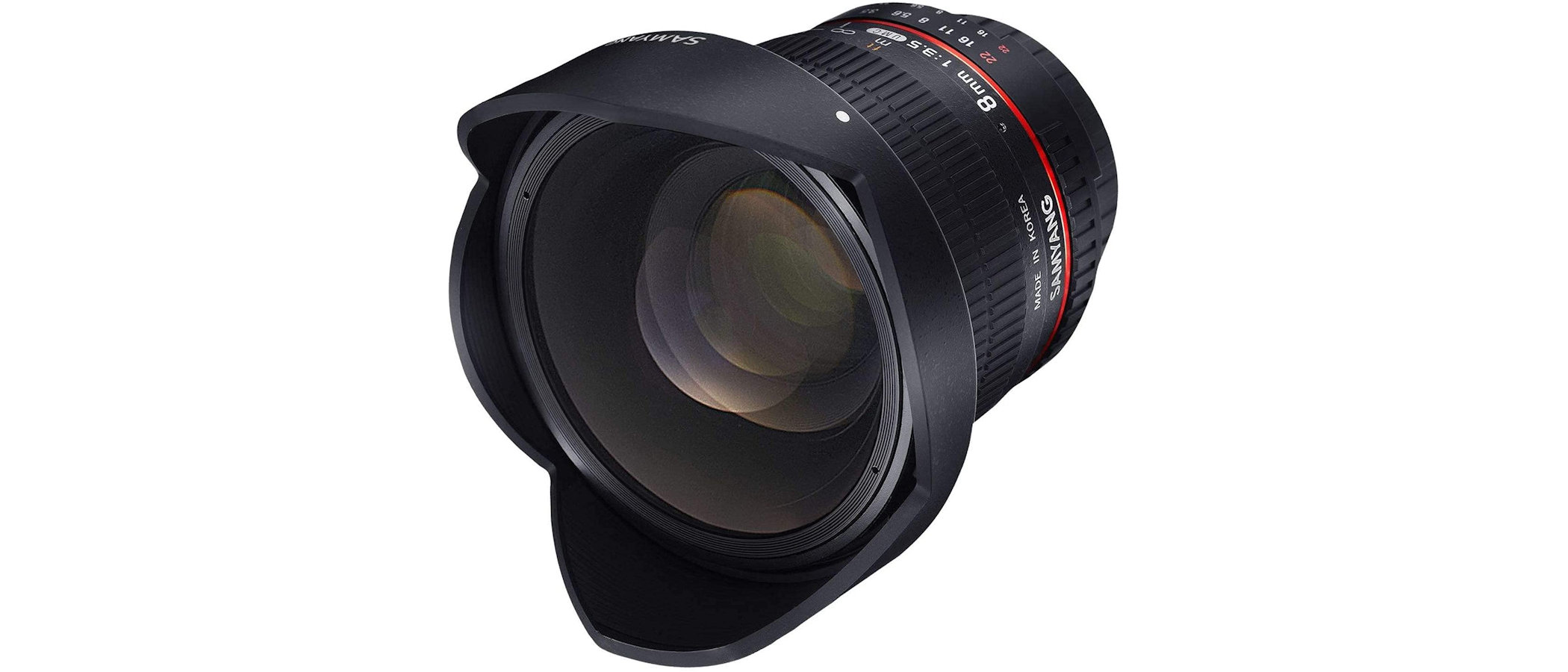Digital Camera World Verdict
Available in a whole heap of different mount options, this diagonal fisheye lens is designed for crop-sensor cameras of pretty much any and every variety. It can also be used on full-frame cameras, although the image circle won’t cover the whole frame. It’s generally a fully manual lens so you need to adjust both the focus distance and aperture using the lens’s control rings, only the Nikon F mount version enabling camera-based aperture control. Image quality is very pleasing on the whole, although the lens is quite susceptible to ghosting.
Pros
- +
Ultra-wide viewing angle
- +
Good build quality
- +
Competitive selling price
Cons
- -
Susceptible to ghosting
- -
Generally only aperture control from the camera
Why you can trust Digital Camera World
Typical of diagonal fisheye lenses, the Samyang 8mm f/3.5 UMC Fish-Eye CS II gives an ultra-wide viewing angle, typically of around 180 degrees on most crop-sensor cameras. Its image circle covers the entire surface of the image sensor, so you get full-sized rectangular images but with the exaggerated barrel distortion of a curvilinear rather than regular rectilinear wide-angle lens.
Specifications
Mount: Canon EF, Nikon F (DX), Pentax K, Sony A, Canon M, Fujifilm X, Samsung NX, Sony E, MFT
Full frame: No
Autofocus: No
Stabilization: No
Lens construction: 10 elements in 7 groups
Angle of view: 167-180 degrees (mount dependent)
Diaphragm blades: Unspecified
Minimum aperture: f/22
Minimum focusing distance: 0.3m
Maximum magnification ratio: Unspecified
Filter size: None
Dimensions: 78x74-101mm (mount dependent)
Weight: 410-515g (mount dependent)
Key features
There’s no shortage in the mount options available for this lens, which include Canon EF, Nikon F, Pentax K, Sony A, Canon M, Fujifilm X, Samsung NX, Sony E, MFT. It’s designed for crop-sensor cameras and the angle of view, measured on the diagonal of the frame, varies with different versions. For example, you get a full 180 degrees for most APS-C cameras, shrinking to 167 degrees for Canon EF and M mount editions, and just 139 degrees for Micro Four Thirds.
There’s also a variation in the physical length of the lens depending on mount option, from 73mm for the Nikon F version to 101mm for the Canon M, Fujifilm X and Sony E editions. The weight also varies from 410g to 465g.
It’s generally what’s often referred to as a ‘dumb lens’, in that there’s no communication between the lens and camera. You therefore need to adjust the focus and aperture setting by using the lens’s onboard control ring. A downside for shooting with a DSLR is that you get a dark viewfinder image when using narrow apertures, and you can’t shoot in the full range of PASM modes. The only exception is the Nikon F mount edition, which enables camera-driven aperture control.
The optical patch includes a hybrid aspherical element and an anti-reflective multi-coating, the latter aiming to minimize ghosting and flare. The petal shape hood is an integral part of the lens and protects the protruding front element but a DH (Detachable Hood) version is also available.
Performance
The lack of autofocus generally isn’t an issue, thanks to the huge depth of field. In our tests, we found that by setting the focus just shy of its infinity setting when shooting at f/8, everything from as little as half a meter away to the far horizon retained sharpness. Sharpness itself is pretty good across the entire image frame, and color fringing is fairly minimal. Our only reservation is that when bright light enters the lens from an oblique angle, ghosting is a more prevalent problem than usual for a fisheye lens.
Example shots
Lab results
We usually run a range of lab tests under controlled conditions, using the Imatest Master testing suite. Photos of test charts are taken across the range of apertures and zooms (where available), then analyzed for sharpness, distortion and chromatic aberrations.
However, due to the relatively small size of test charts and the enormous 180-degree viewing angle of fisheye lenses, it’s impossible for us to generate meaningful lab-test data for them.
Verdict
Available in a whole heap of different mount options, this diagonal fisheye lens is designed for crop-sensor cameras of pretty much any and every variety. It can also be used on full-frame cameras, although the image circle won’t cover the whole frame. It’s generally a fully manual lens so you need to adjust both the focus distance and aperture using the lens’s control rings, only the Nikon F mount version enabling camera-based aperture control. Image quality is very pleasing on the whole, although the lens is quite susceptible to ghosting.
Read more:
The best camera deals, reviews, product advice, and unmissable photography news, direct to your inbox!
• Best camera lenses to get
• Best Canon lenses
• Best Nikon lenses
• Best Sony lenses
Matthew Richards is a photographer and journalist who has spent years using and reviewing all manner of photo gear. He is Digital Camera World's principal lens reviewer – and has tested more primes and zooms than most people have had hot dinners!
His expertise with equipment doesn’t end there, though. He is also an encyclopedia when it comes to all manner of cameras, camera holsters and bags, flashguns, tripods and heads, printers, papers and inks, and just about anything imaging-related.
In an earlier life he was a broadcast engineer at the BBC, as well as a former editor of PC Guide.



